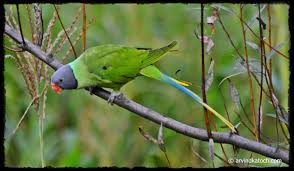Slaty-Headed Parakeet

Description
The slaty-headed parakeet (Psittacula himalayana) is the only psittacid species to exhibit altitudinal migration. The species' range extends from Pakistan, to Western Himalayas in India through Nepal and Bhutan and up to the Eastern Himalayas in the northeastern Indian state of Arunachal Pradesh. They descend to the valleys in winter, approximately during the last week of October.
Adults of both genders have green (tinted with blue) feathers on most of their body. It has a dark grey (slate colored) head with a light blue tint where head meets the neck. Males feature dark maroon patches on inner wing coverts. Females do not feature these maroon patches. Males have long central tail feathers but, is shorter in female birds. The tail is green at base and becomes deep blue and widely tipped with bright yellow. The parakeet features a bright red-orange upper mandible with a pale yellow lower. It also has a pale yellow eye.
Scientific Name
Psittacula Himalayanaeity
Country Of Origin
Size
Life Expectancy
Noise Level
Talk / Trick Ability
Low talking ability; fair trick ability
Characteristics
The slaty-headed parakeet makes an excellent pet for those who understand its needs and its nature. Initially, this species can be shy and even nervous, but with proper socialization they can become calm and confiding with their owners. Because they tend to get along well with other birds, they can be housed in communal aviaries even with smaller birds. While they do not generally learn to speak, they make melodious chattering sounds and are comfortable with owners who gain their trust.
Behavior / Health Concerns
Slaty-headed parakeets are susceptible to wet, cold conditions, so care should be taken to keep the temperature in their environment warm and consistent. Younger birds in particular are more sensitive to climate changes. They need a wide variety of seed mix in their diet, along with millet, fruit, greens, vegetables, as well as eggfood. Immature birds of this species need a vitamin-C supplement during their first year. Slaty-headed parakeets can be very aggressive toward other Psittacula to other species, especially plum-headed parakeets, during breeding season.
Expert Advice
“Slaty-headed parakeets are medium-noisy, hardy, active birds that, while initially may be shy, grow to be calm and confiding.”
Zahir Rana (www.psittacula-world.com)